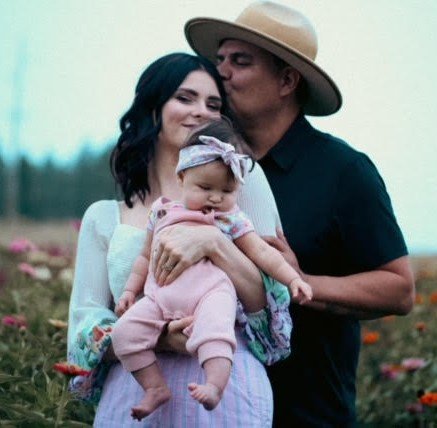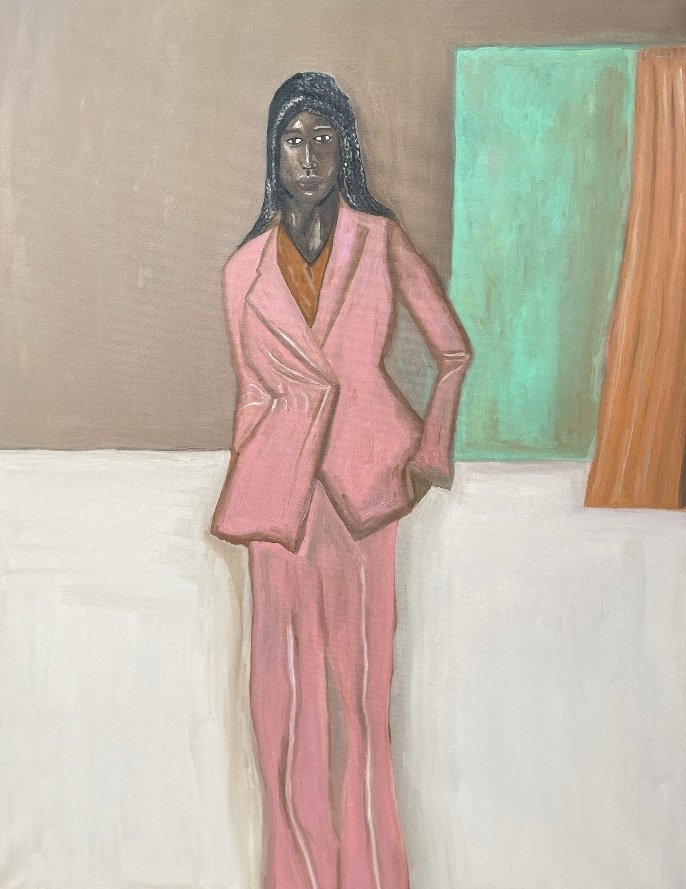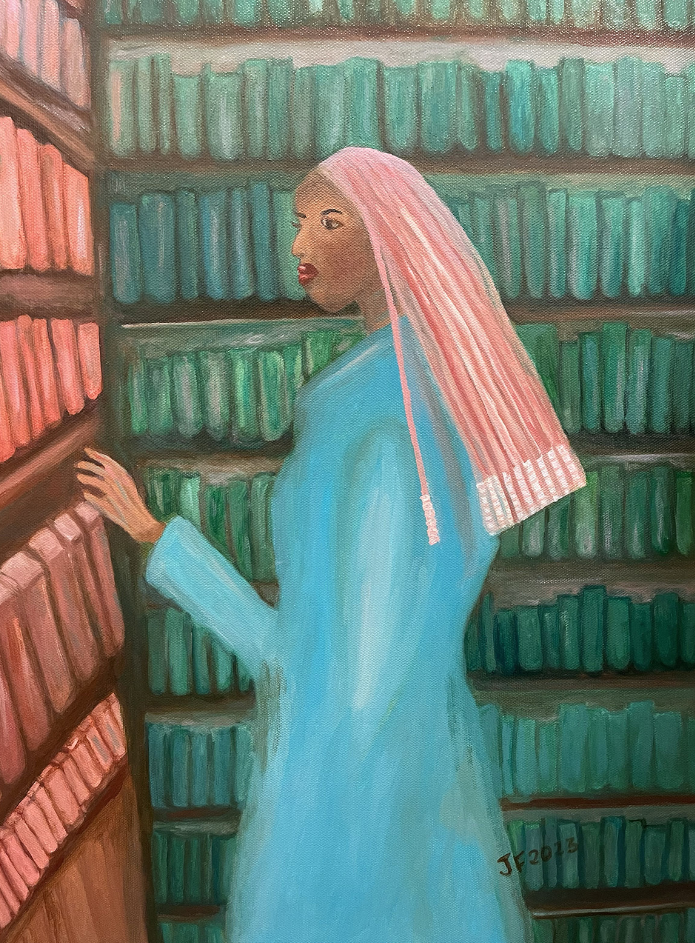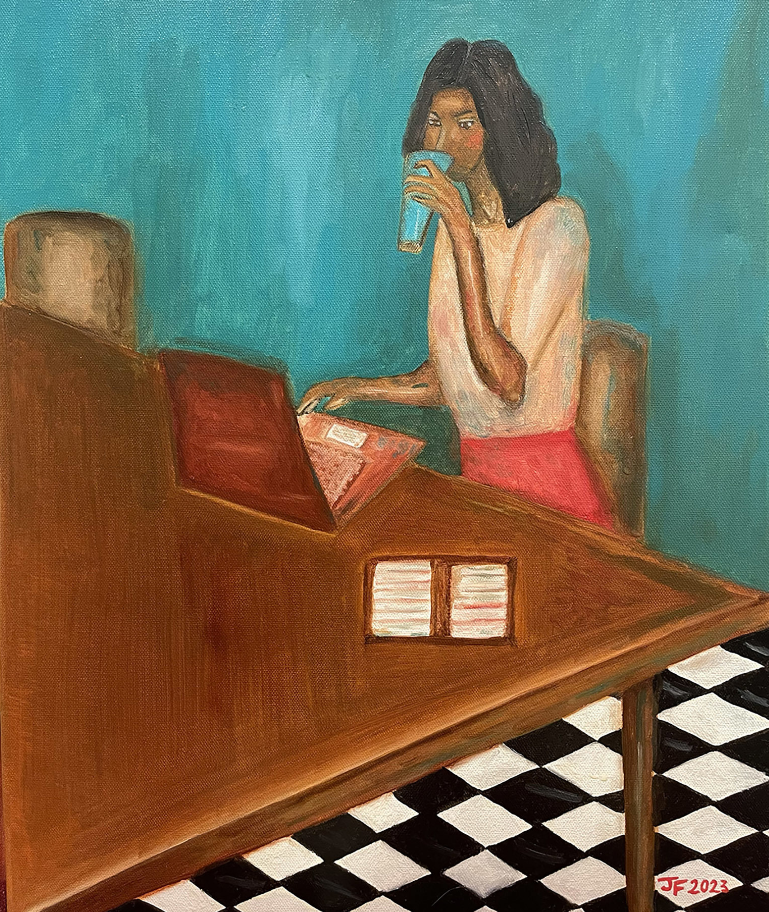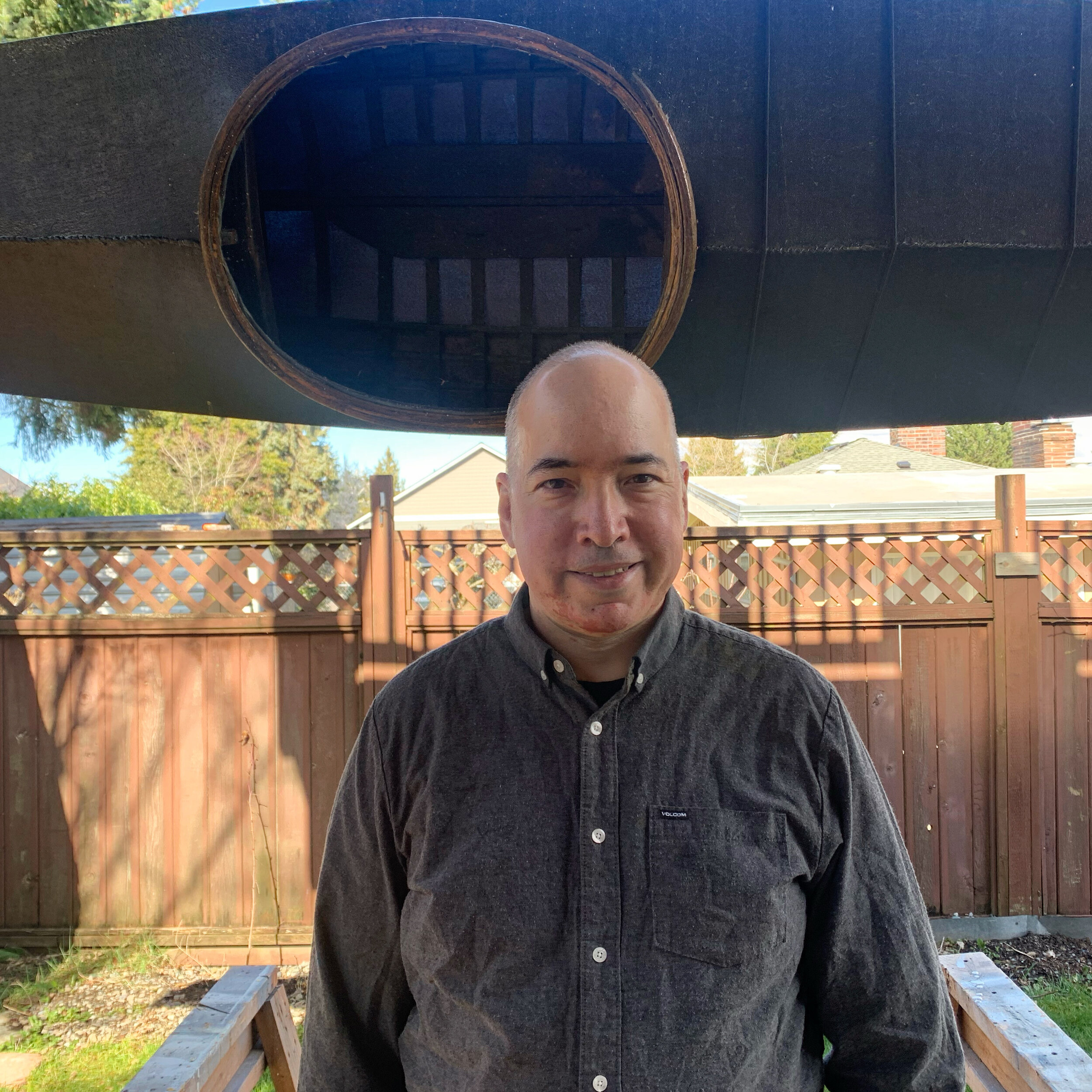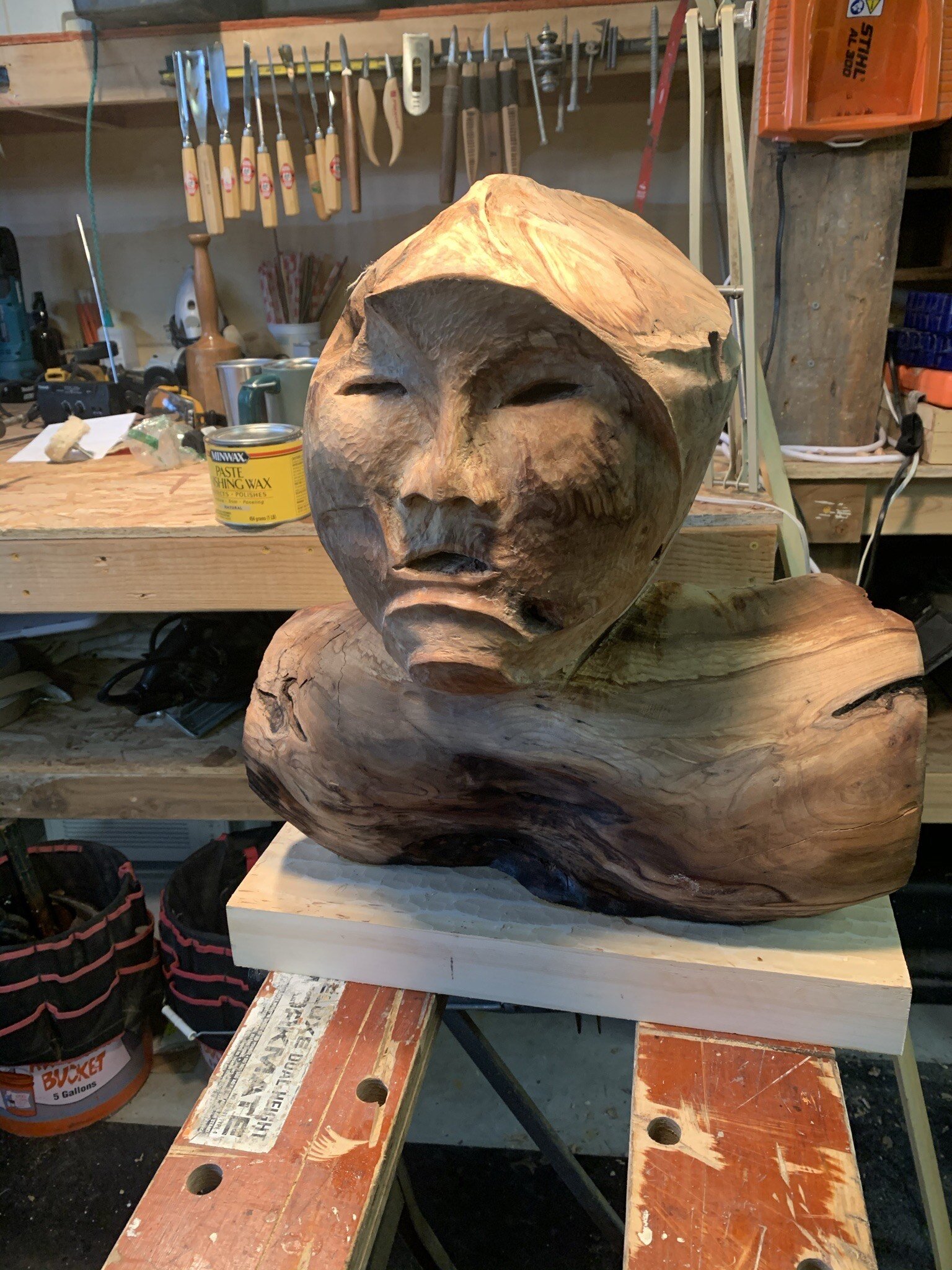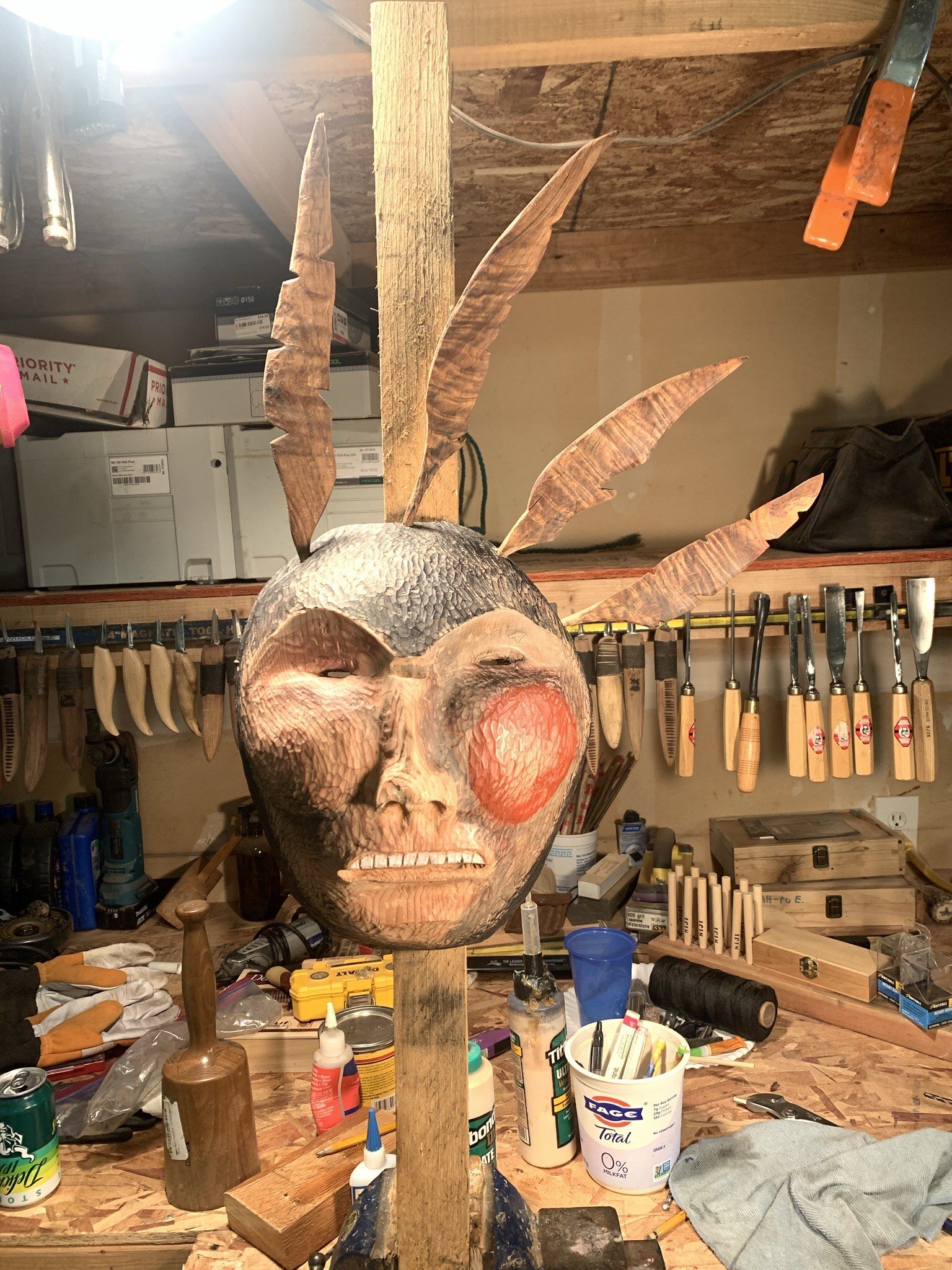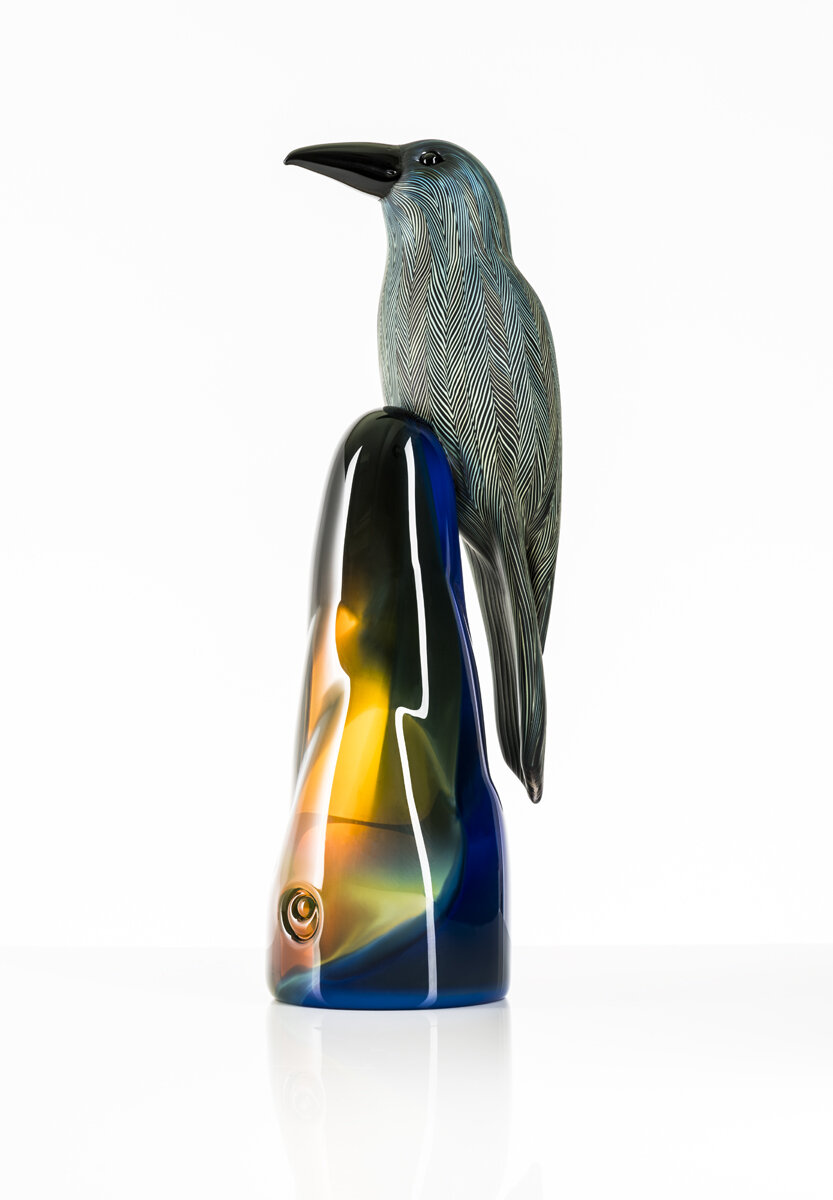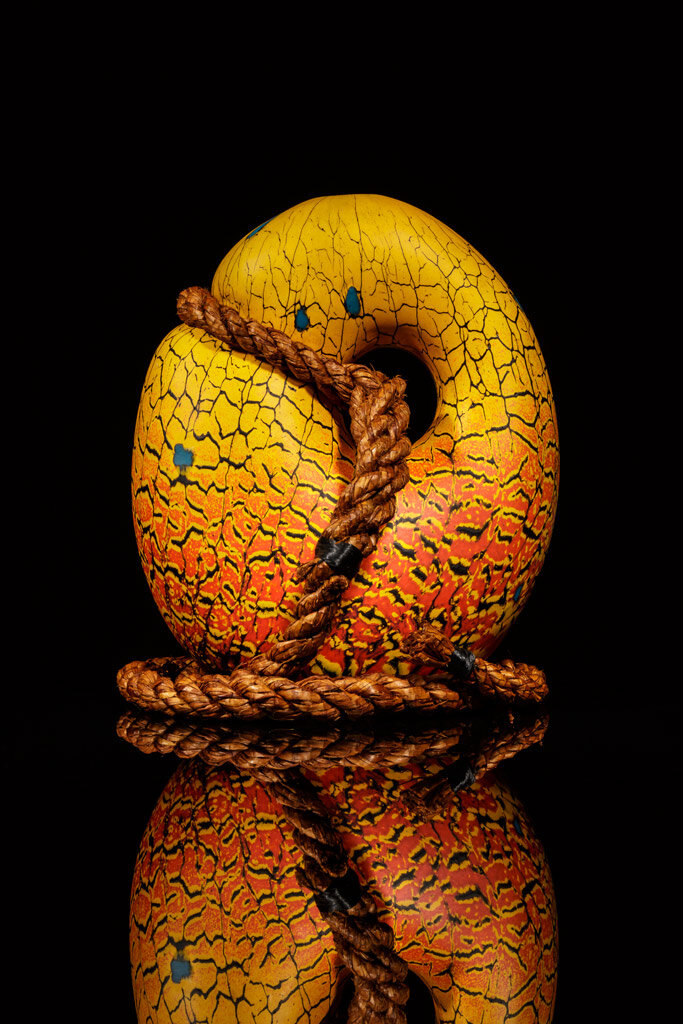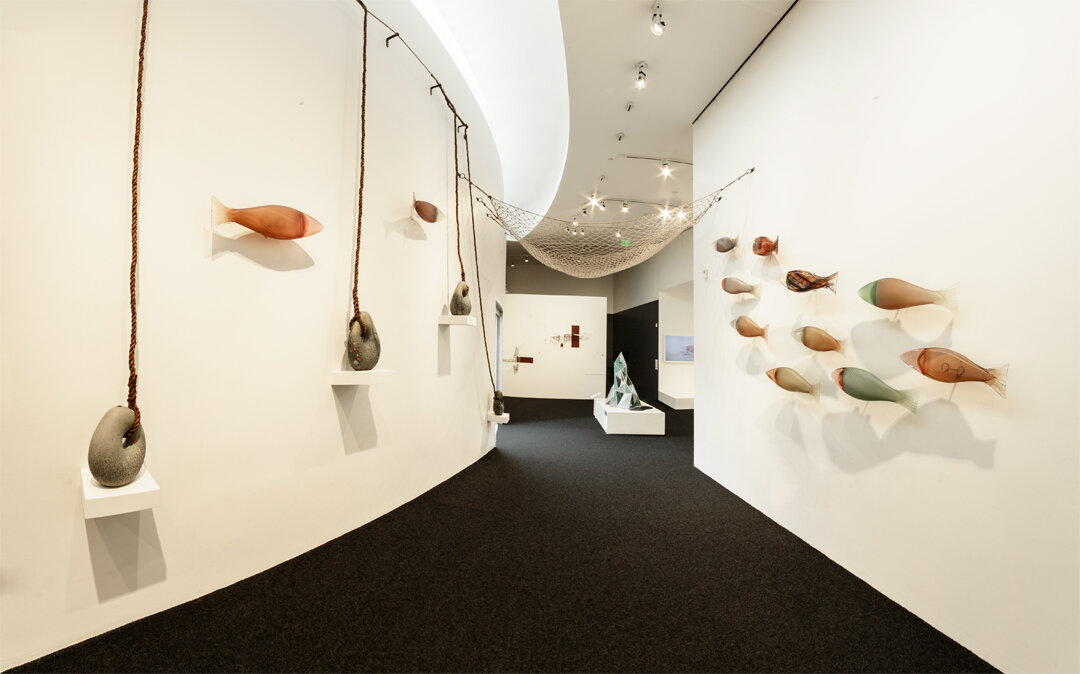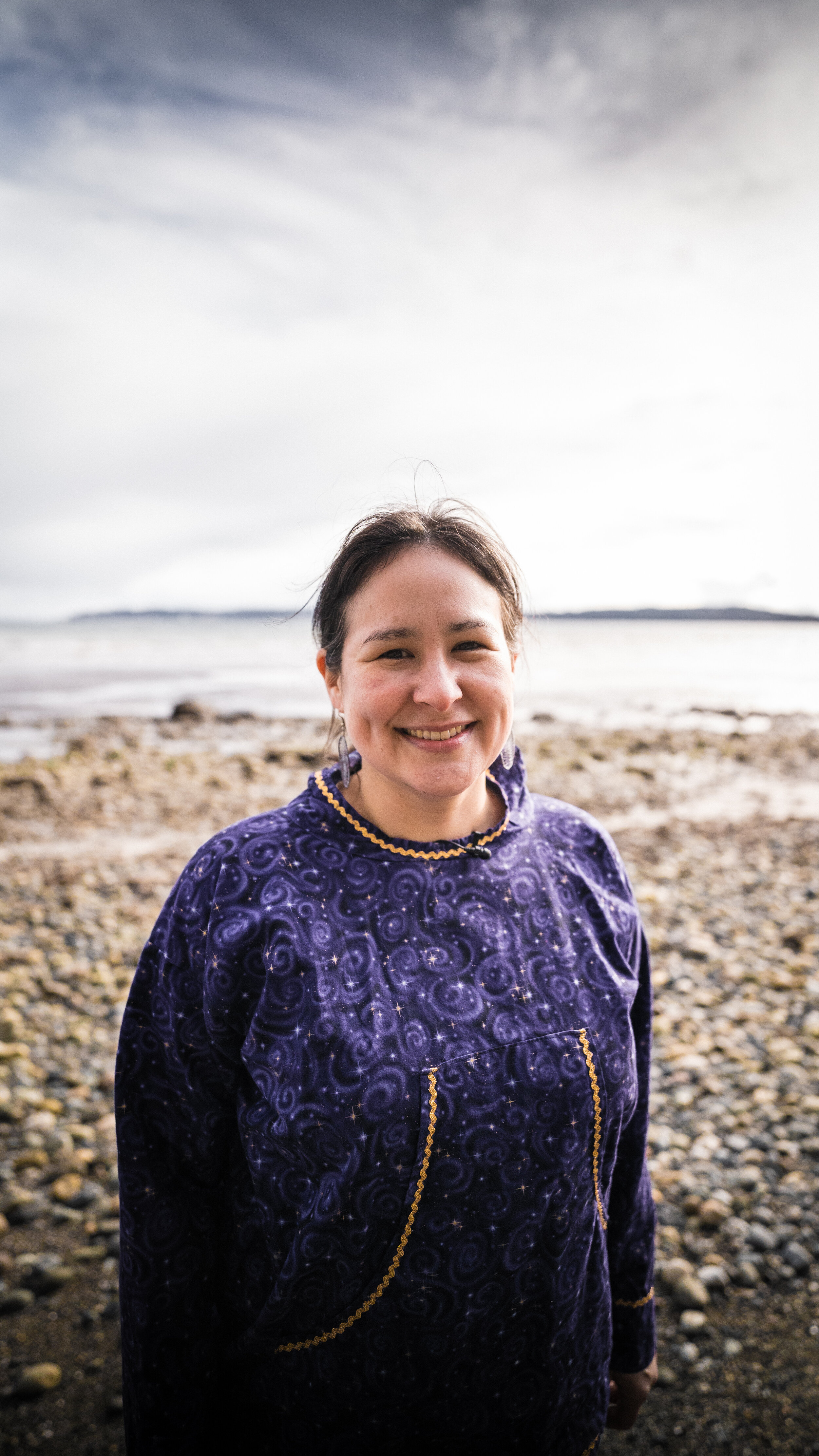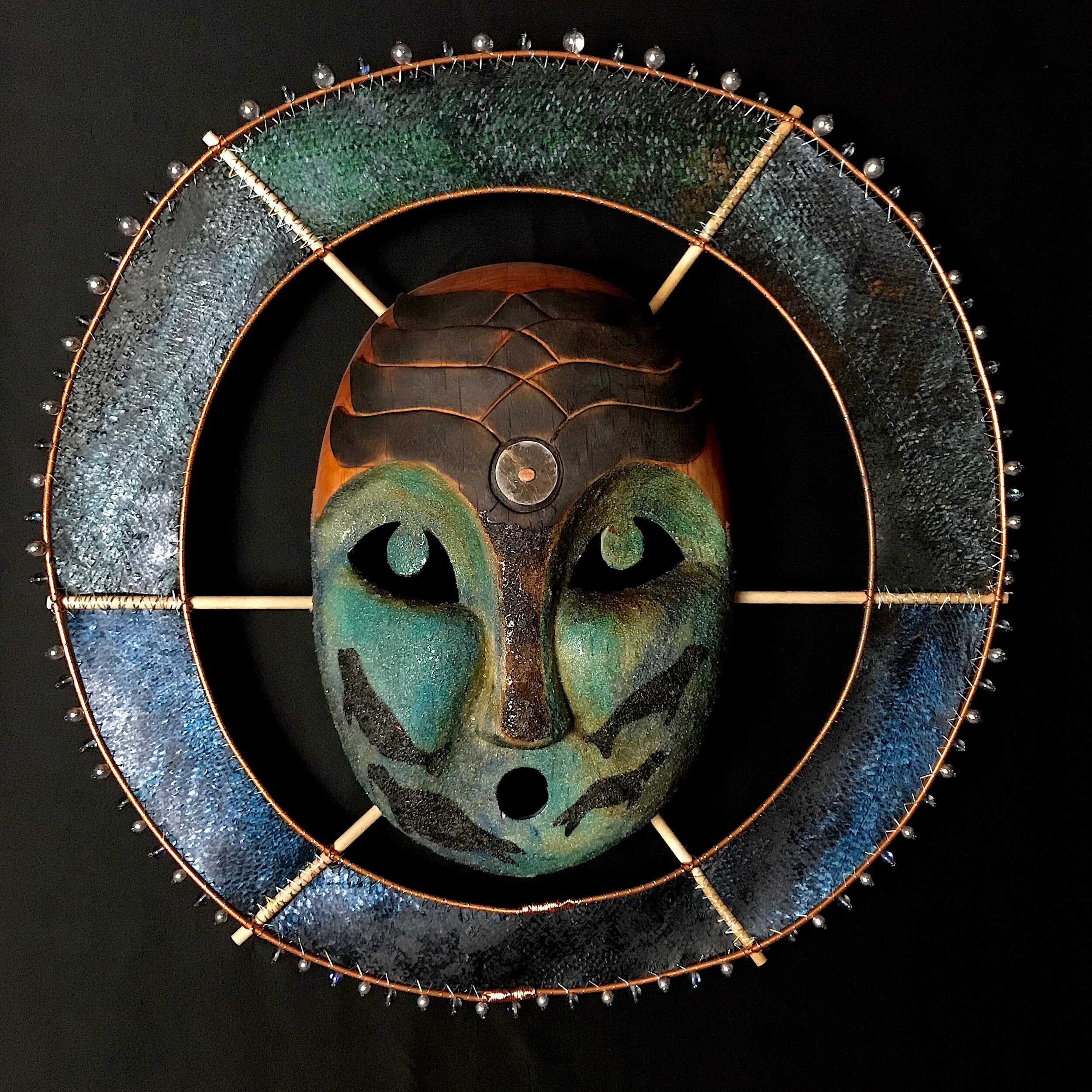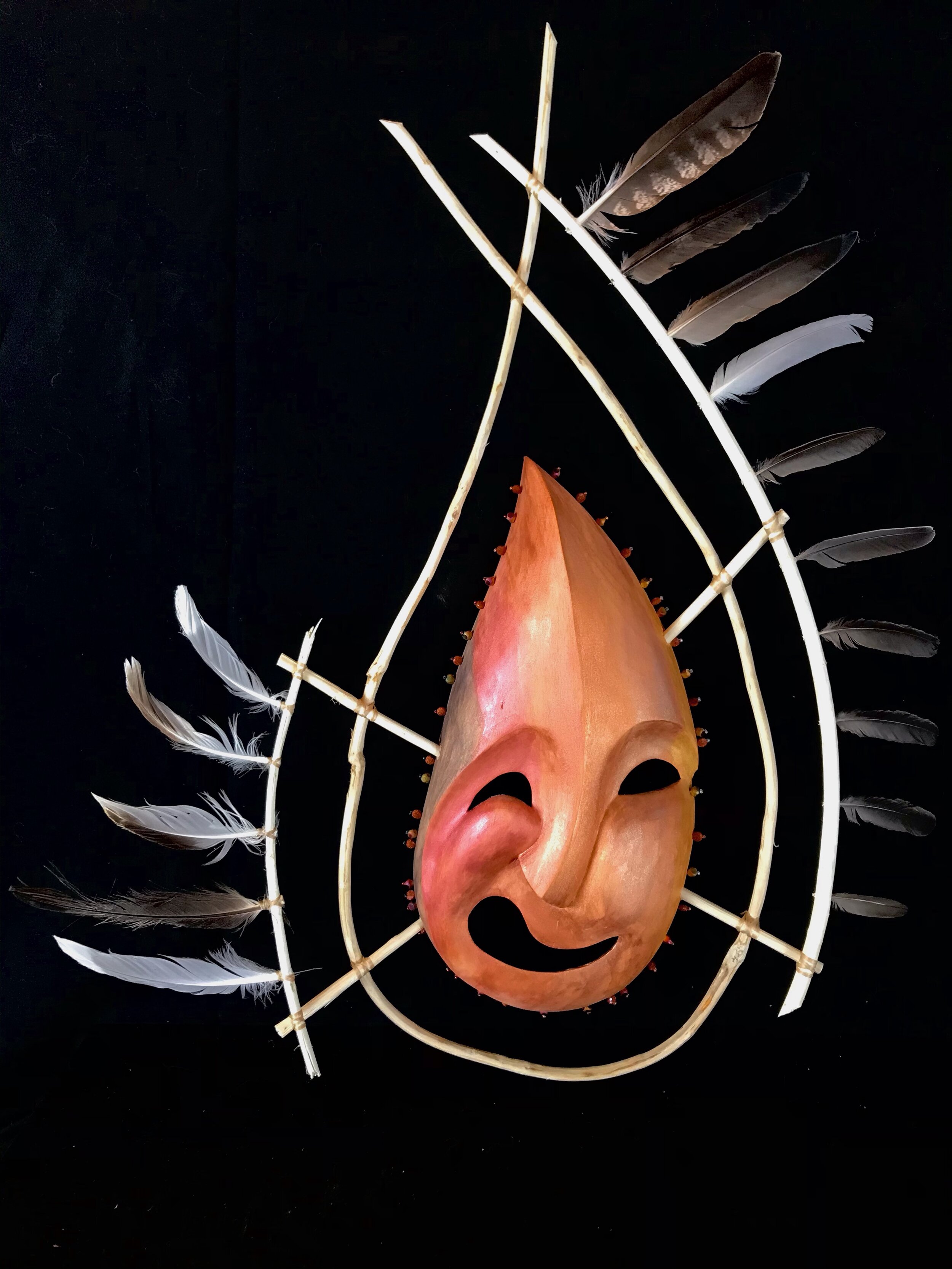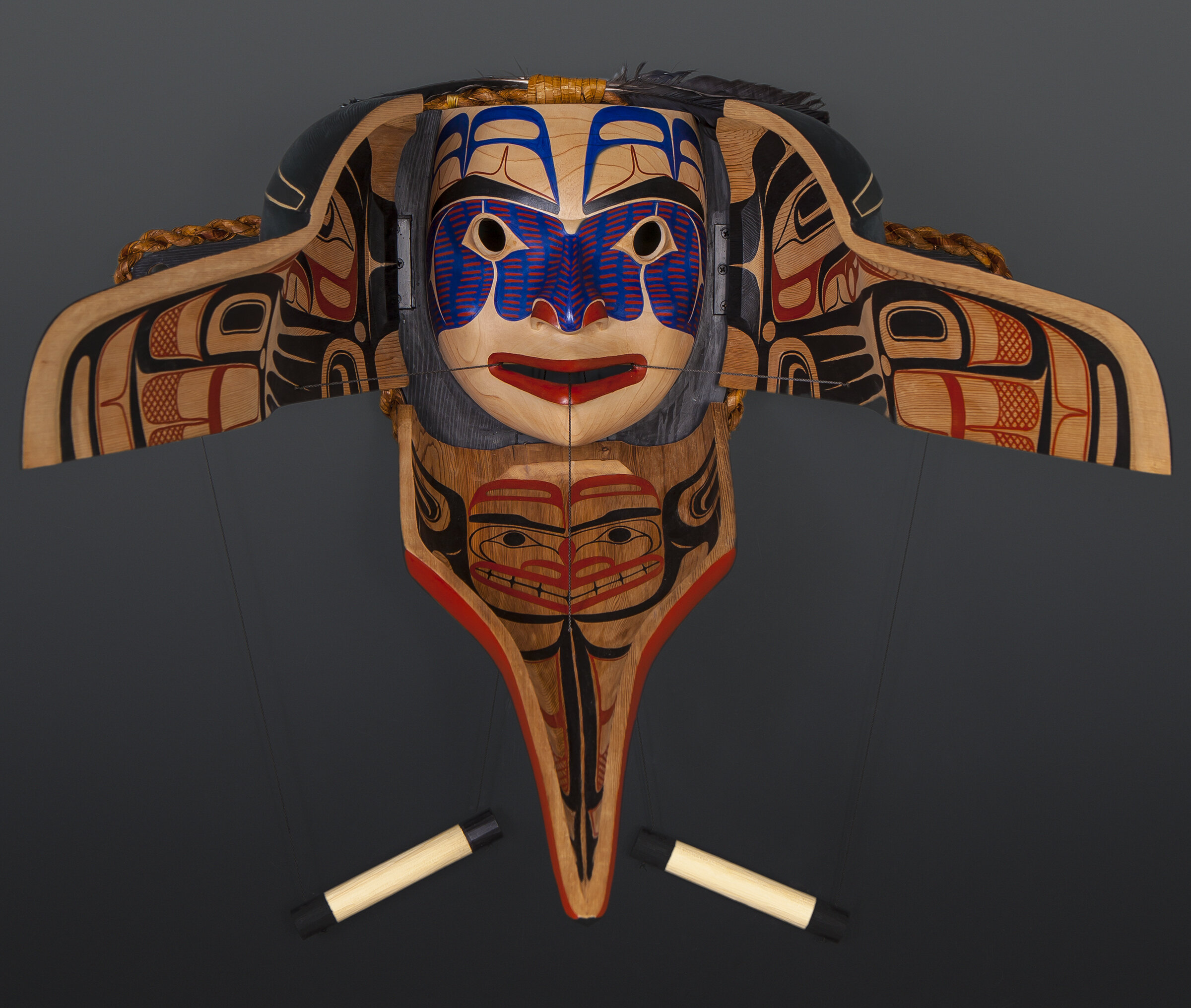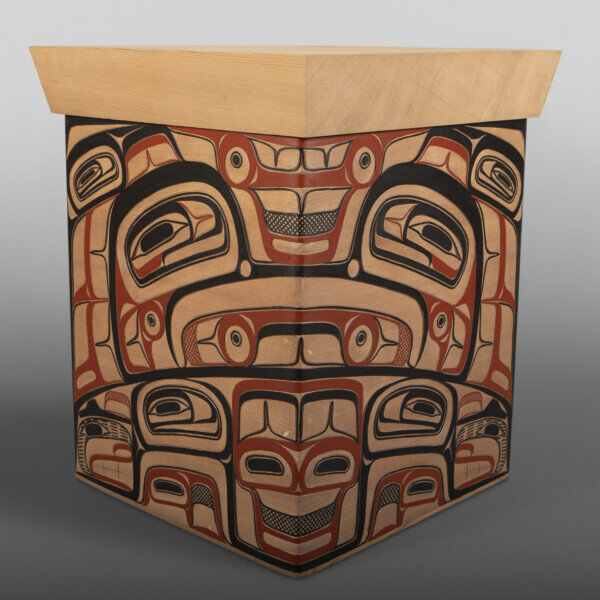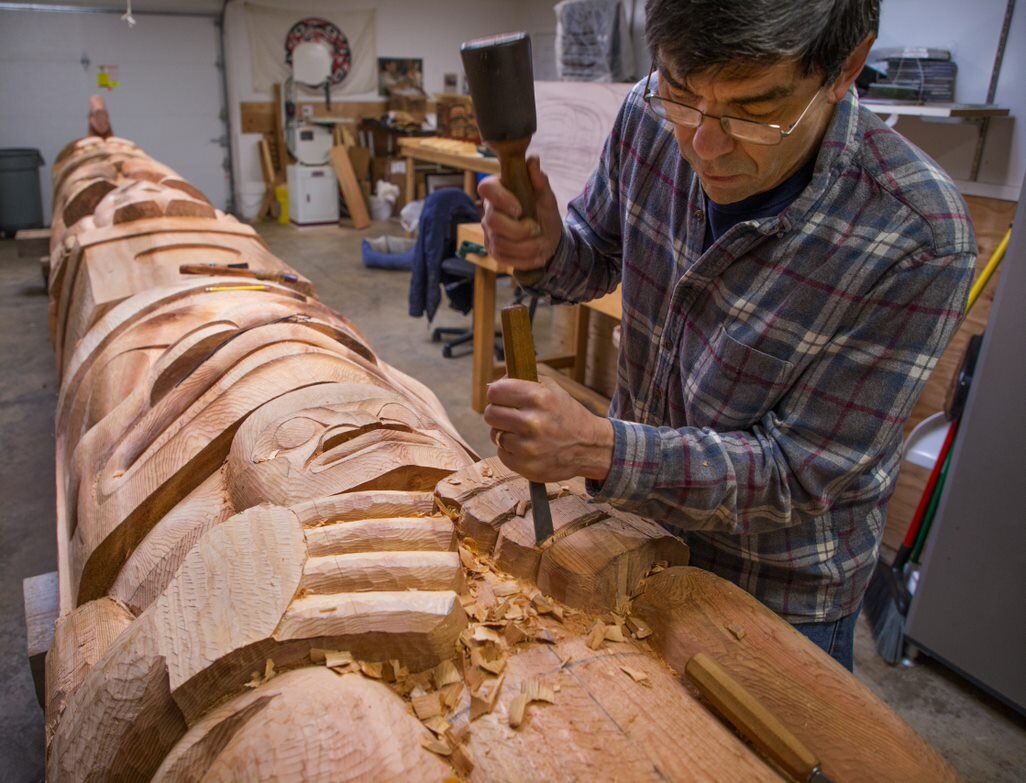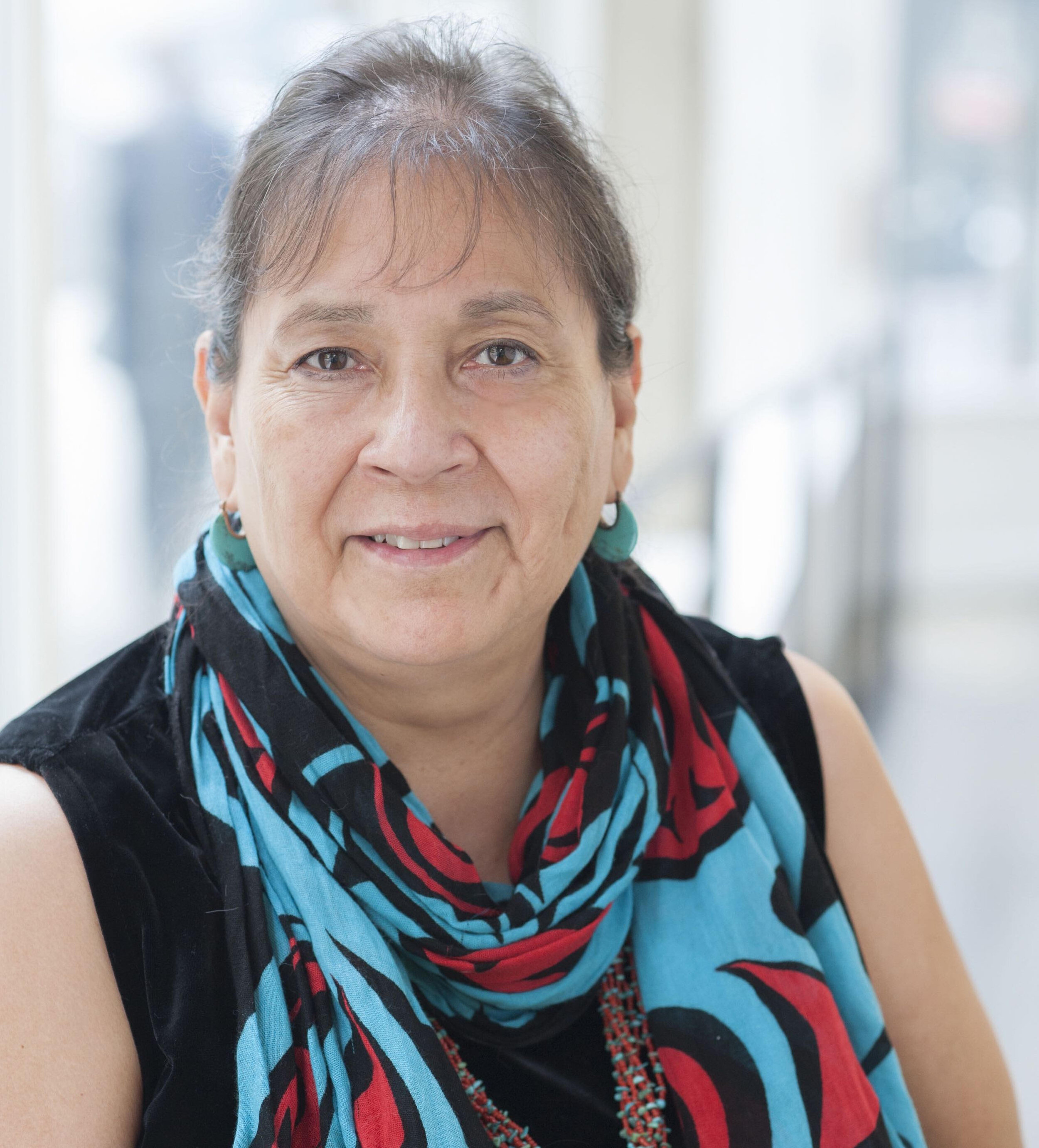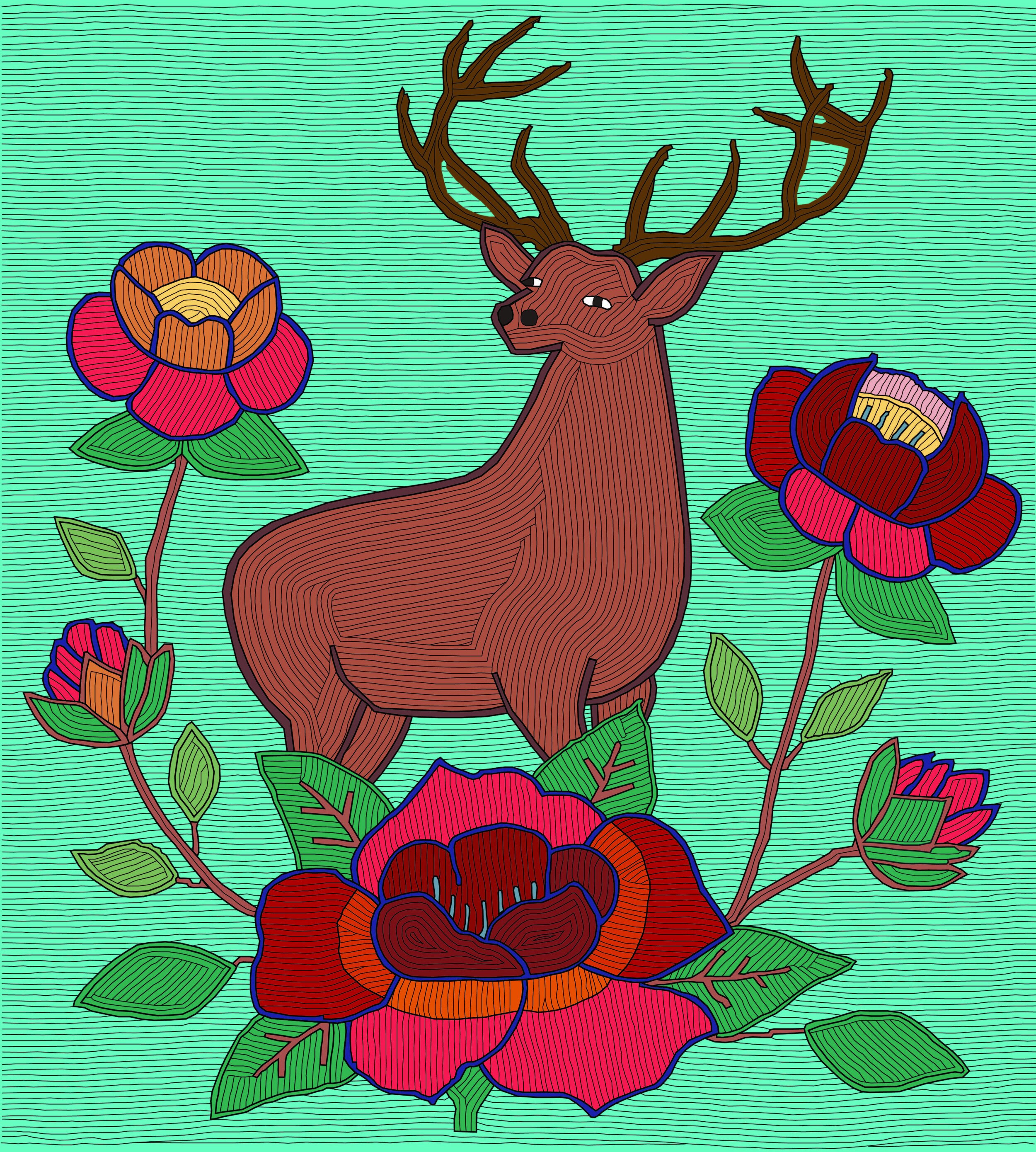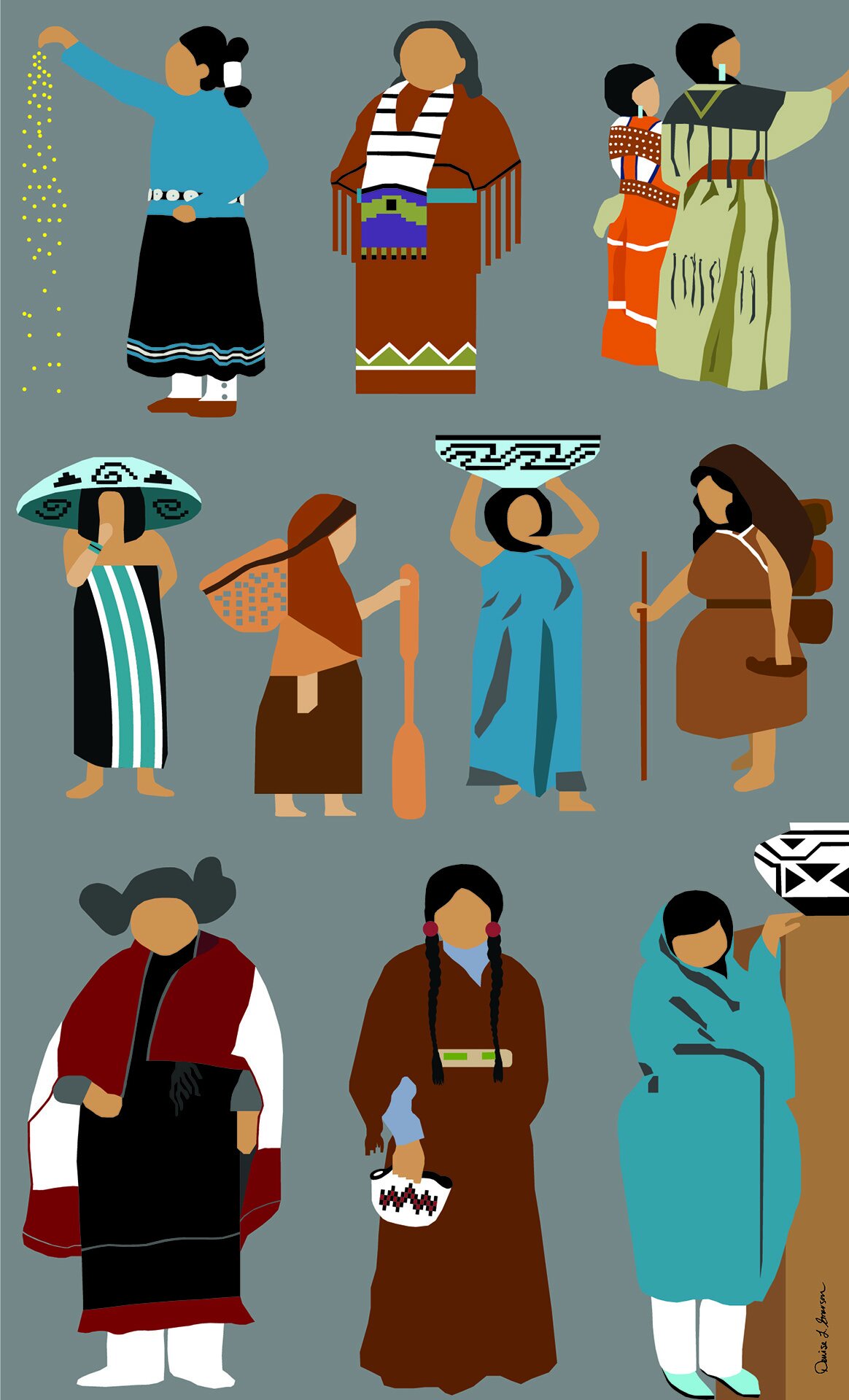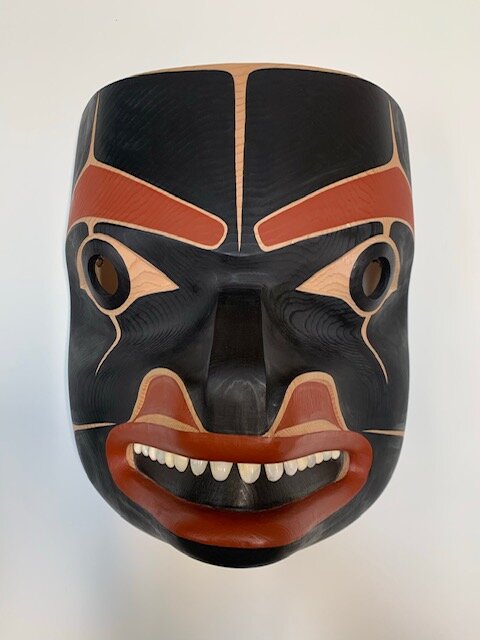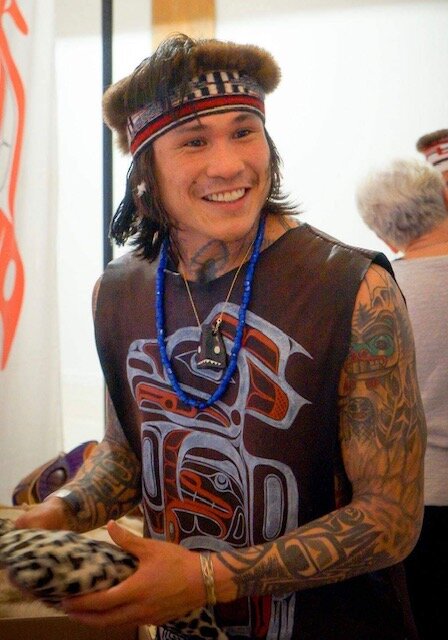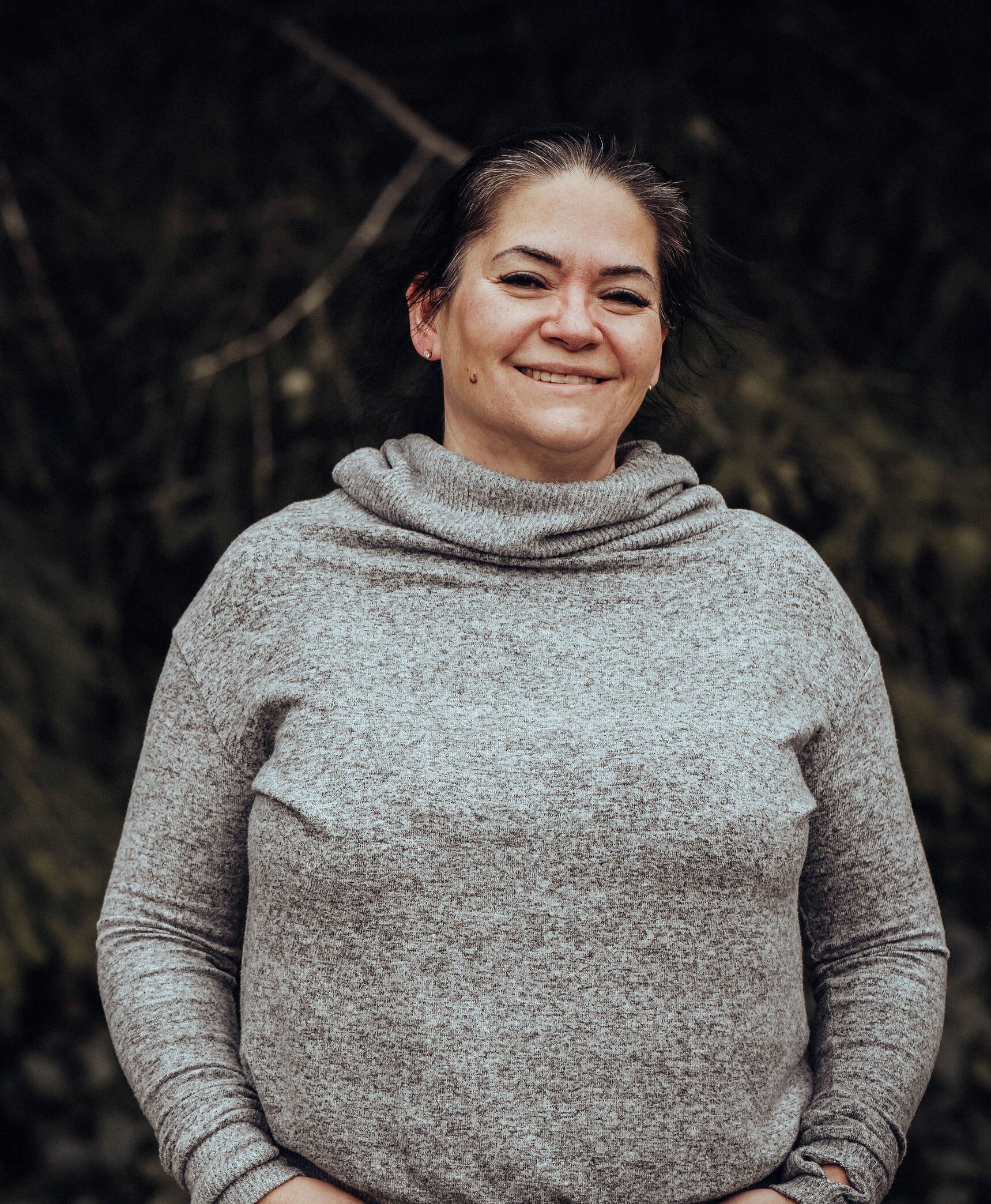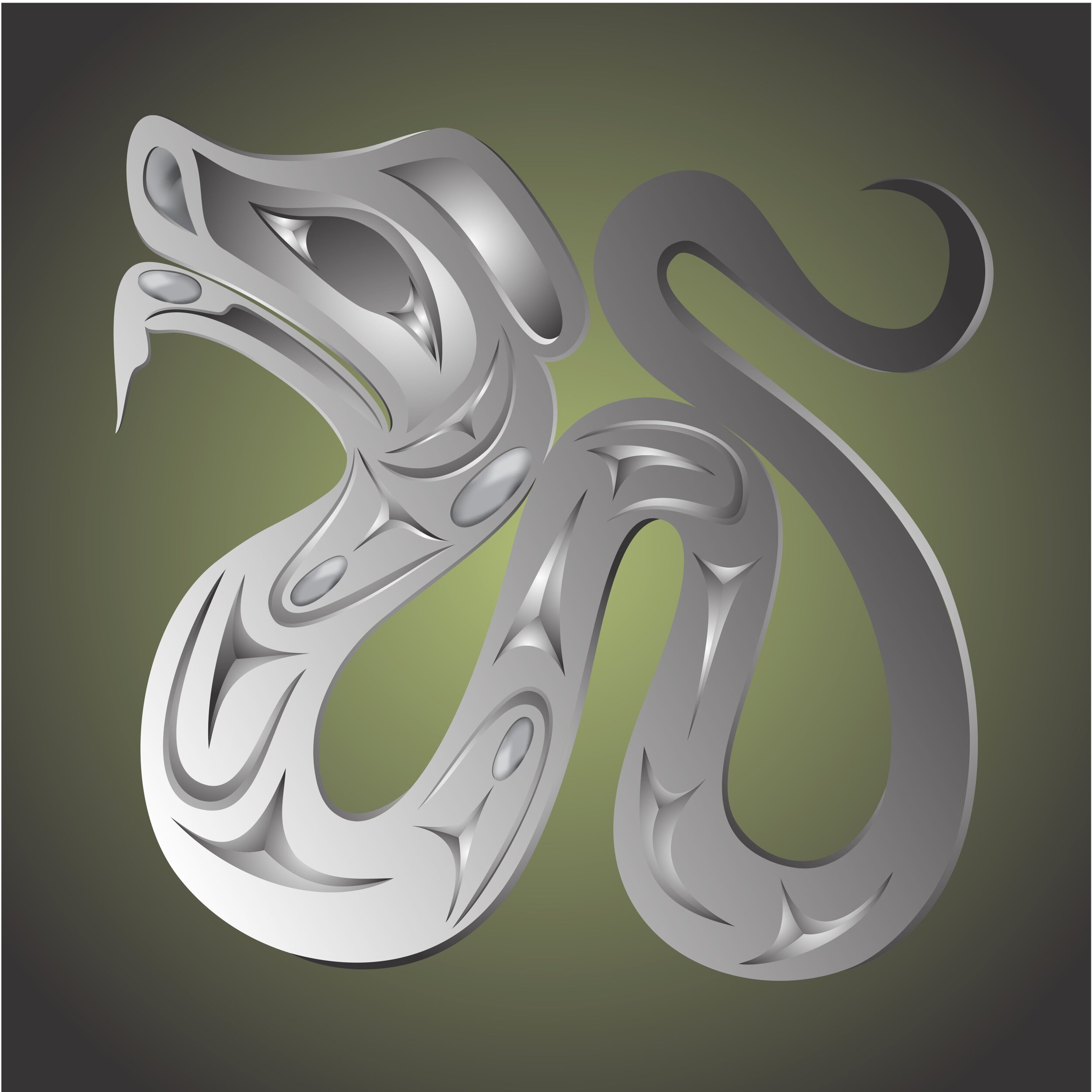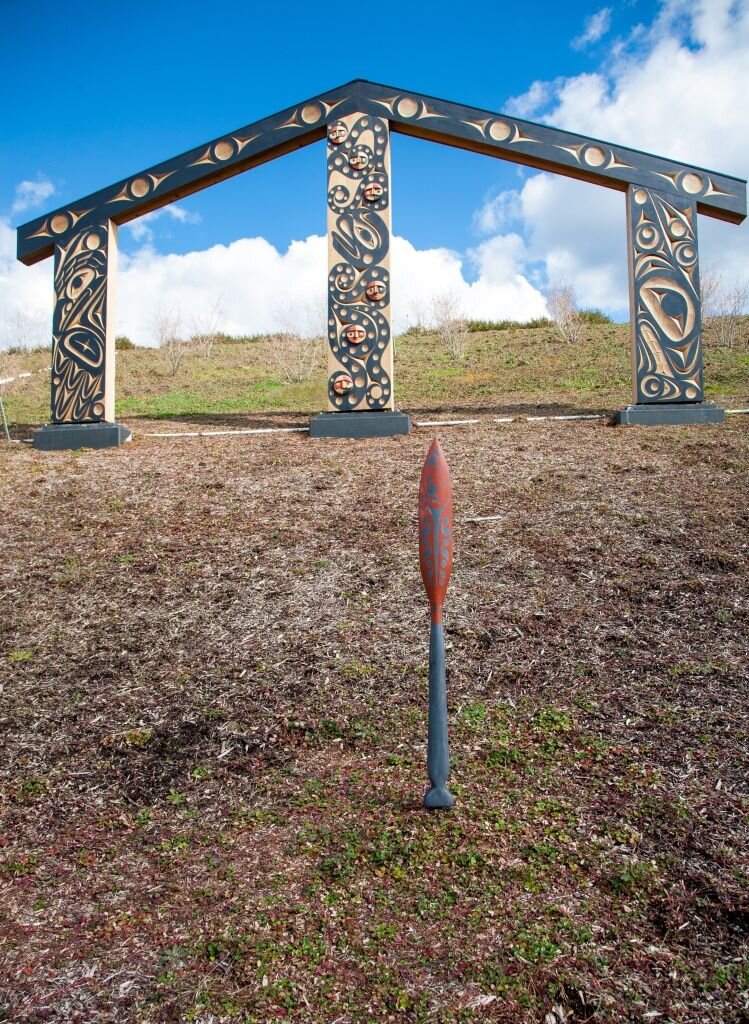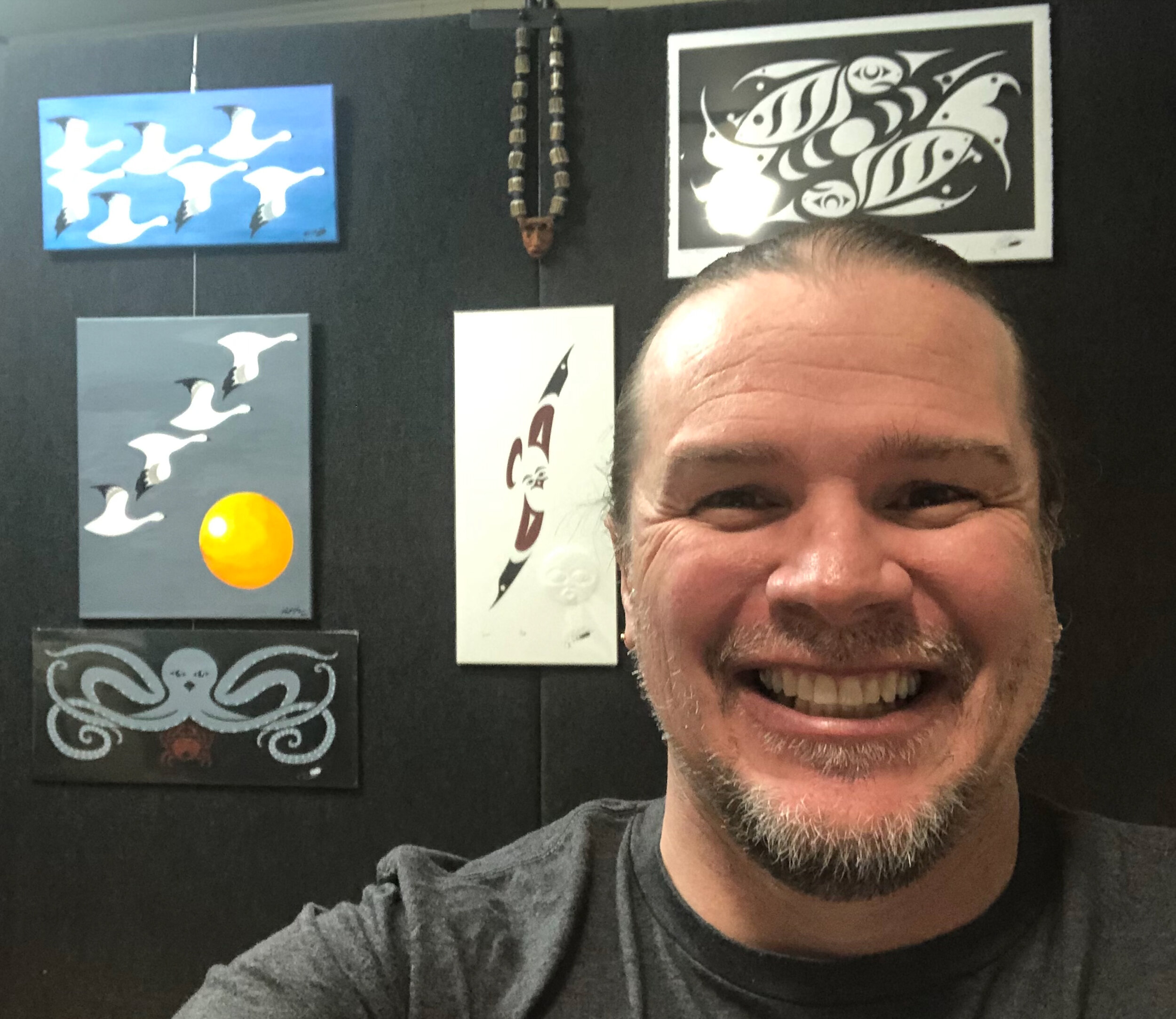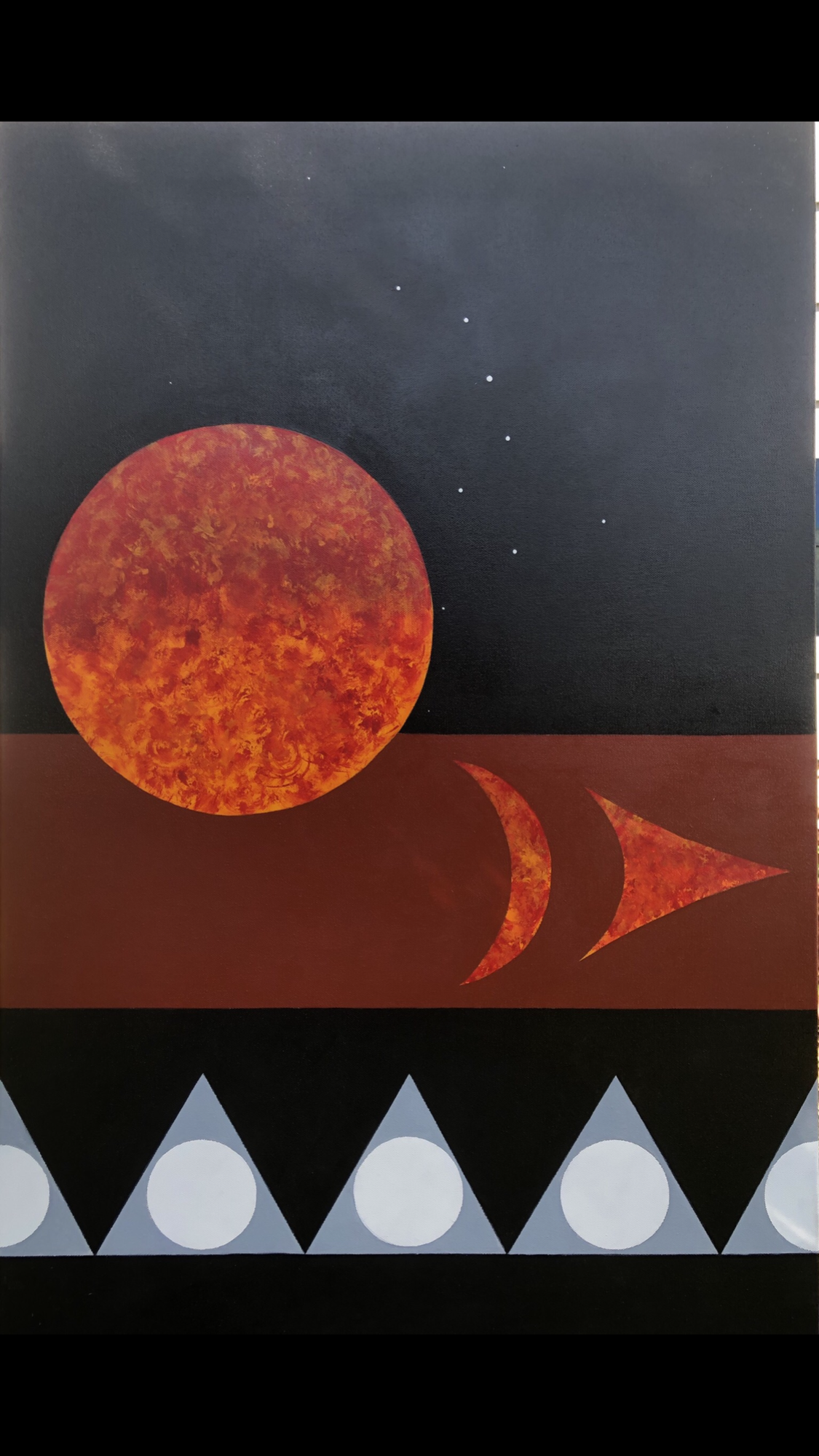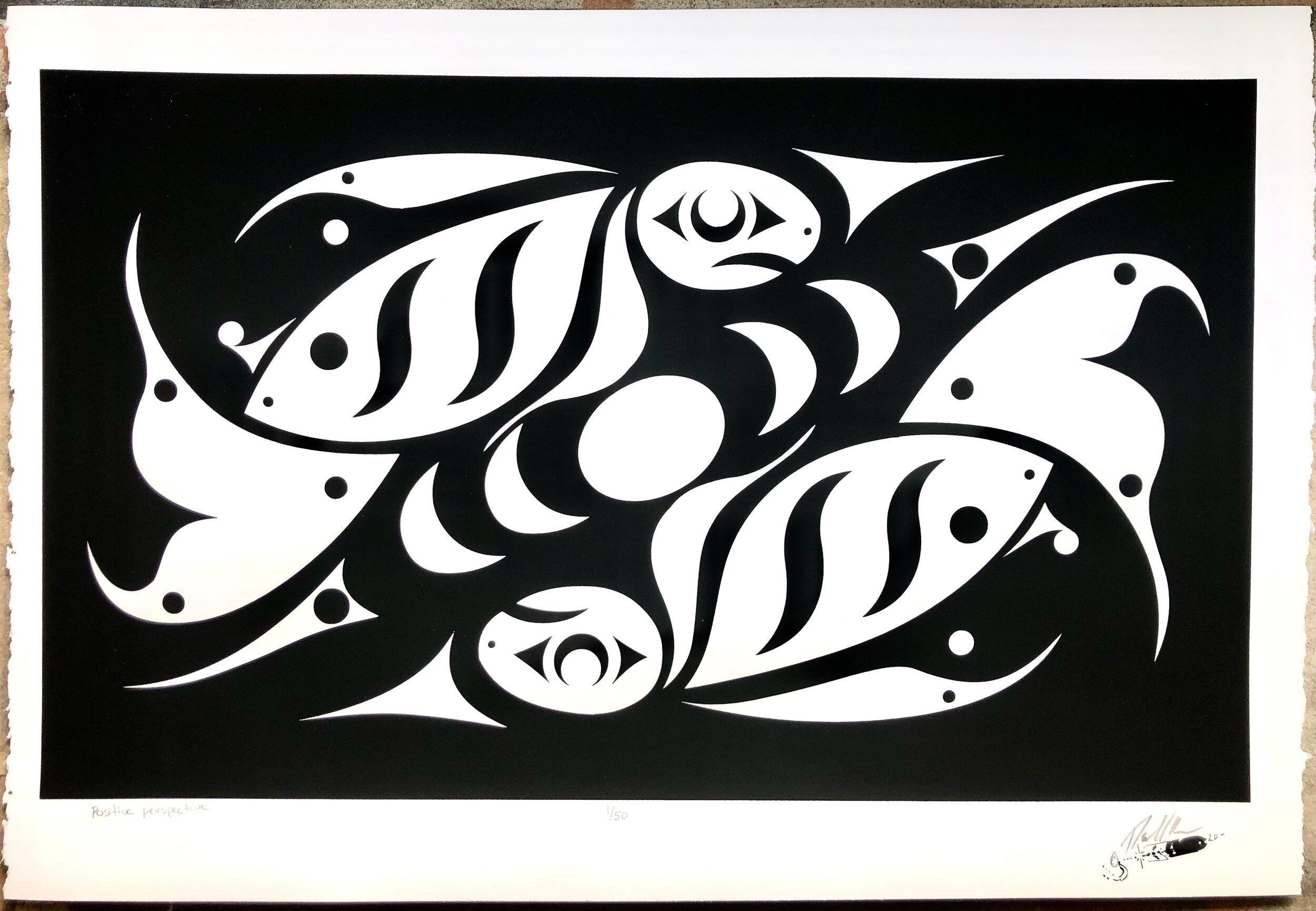Read an interview about Lisa and Sonny HERE
We are a married artist duo who collaborate simultaneously on the same canvas using primarily oil paints by combining our abstract and realistic styles to create expressionist paintings. Our unique collaborations evoke human emotions and vulnerability through painterly lines and vivid colors. We allow the painterly lines to show through in our work to display our process. Each layer takes weeks, and often months to dry.
It can take years for one painting to reach completion. Our works express the balance between reality and distortion. When looking closely you can see each individual stroke of paint working together in unison to complete the picture.
As Indigenous artists, culture has inspired many of our works and we hope to remind people of the importance of indigenous people, and the struggles they have had to overcome, both in the past and present. We want the viewer to experience the spirit of the Indigenous people and the importance of working together. Visit Lisa and Sonny Moeckel’s booth at the 2024 Best of the Northwest Spring Show. Visit their website HERE
In my artistic practice, I engage with the timeless medium of oil painting, utilizing its rich textures and vibrant colors to convey stories inspired by the narratives of women. Influenced by the expressive styles of renowned artists such as Pierre Bonnard and Henri Matisse, my work seeks to capture the essence of feminine experiences.
The versatility of oil allows me to explore a wide spectrum of emotions and narratives on canvas. Layering is a fundamental technique in my process, enabling me to build depth and complexity within each composition. My fascination with the intimate tales of women is evident in my choice of subjects and themes. Whether portraying moments of introspection, celebration, or resilience, I draw from personal experiences and universal aspects of womanhood. See more of Lisa’s work HERE
NATIVE ARTISTS OF THE SALISH SEA
Introduction by Linley Logan
“These talented cultural artists represent Coast Salish, Alaskan Native, and First Nations artists living and thriving in the Salish Sea area. They are rooted in their foundation of traditional expressive art to contemporary Indigenous art and materials including the mastery of glass as a medium, and computer technology as a platform to develop artistic imagery.
The artists range from older renowned and culturally award recognized artists to what I consider the next and New Wave of indigenous contemporary and cultural artists in the Salish Sea area.
Artists like David Boxley have worked to breathe new life and cultural strength into cultural art traditions including song and dance. Dan Friday has translated cultural art into the medium of glass. Younger artists breathe renewed life into strengthening their cultural art traditions into a contemporary artistic expressive language for the future. We are all cultural and artistic architects bridge-building indigenous artistic expressive language into the future. As Indigenous people, we are culturally wealthy with art in our communities.”
LINLEY B. LOGAN, multi-disciplinary artist, curator and cultural art consultant
(Onondowaga aka Seneca Nation, Six Nations Iroquois Confederacy)
Linley is a multi disciplinary contemporary artists and designer with his creative foundation including his Seneca traditional arts. His applied artistic statement is conveyed through contemporary artistic expression. Linley’s contemporary artistic experience includes printmaking, painting, pottery, traditional beaded jewelry and contemporary jewelry, 3-dimensional arts, sculpture, glass, and design work. His fine arts background includes Industrial design, graphic design and set design.
Linley is an award winning artists, he has a 35 year history of exhibiting his work including internationally, and he has curated contemporary indigenous international art exhibits. He has attended six International Indigenous Visual Arts Gatherings by invitation. He has consulted to numerous art organizations and art events. He has served on numerous local state, regional, art organization boards. “I live a life of art in the art of life”
Special thanks to Lynn Horton for her help on this exhibit
“My interest in King Island art and craft comes from my family heritage. While growing up, my grandmother told stories of the island in the arctic. Observing my Uncle Lou’s stone carvings, strengthened my sense of Inupiaq design and captured my imagination. Spending time with my family gave me a sense of being from a place of ice, snow and the walrus. Additionally, many Alaska Native people frequent urban environments, which led to other inspirations. For instance, I am working on scaling up traditional carvings from handheld to large-scale sculpture to bring visibility to endangered arts and to inspire continued practices.
My descent into studying the old ways of construction was done by building replications of skin boats (skin on frame kayaks) from the 17th to the 19th century, an endangered craft. Capturing the craftsmanship of the King Island Kayaks of this time, allowed me to bring to life an ancient craft. Through participating in Northwest Inupiat Dance Group, I organized an Umiak build and produced a documentary film through my business Native Kut. The documentary, Umiak Travels, features how the Umiak changes the lives of people in the dance group.
Desiring to widen my horizons led me to continue building my repertoire through carving masks under the influence and direction of renowned artist Larry Ahvakana (Point Barrow, Inupiaq). After becoming an apprentice, I started to better connect with materials and subject matter. Utilizing knowledge of ancient technologies and self-exploration, I produce work that speaks to the experiences of ancestors, myself, and relatives. Many people and animals are impacted by environmental and social issues, which inspires me to incorporate these themes into my work, as our arts always tell the story of what is happening.”
Website- seangallagher.info
Facebook- Native Kut
Instagram- Nativekut
DAN FRIDAY, Lummi Nation
“Creativity was fostered in me by my family from an early age. Living without TV and knowing our rich cultural heritage of the Lummi Nation, meant that making things with our hands was a regular activity. I typically work with simple themes and forms, and often employ subtle silhouettes when making my totems. It is a pleasure seeing inanimate objects taking on a life of their own.
The more narrative work is usually a personal expression or a means of processing a life event, often with a underlying statement. When I saw glass blowing for the first time, it felt as though I grew an inch! That is to say, a huge weight was lifted from my shoulders. I had finally figured out what I wanted to be when I grew up. This was no small feat for someone who, as a youth, was rebellious and misguided. Glass altered my life. In spite of my colorful past, and by the grace of a loving community, I found my passion in glass.
Living as an artist may not be directly saving the world, but perhaps we are saving ourselves and hopefully, in the process, making the world a better place.”
Dan Friday is a member of the Lummi Nation and a Seattle based glass artist. He has spent the last twenty five years creating his own work, and also working with artists such as Dale Chihuly, Paul Marioni, and Preston Singletary. The themes and images of Friday’s work are often drawn from his Coast Salish heritage and are solidified in the world of glass art.
JENNIFER ANGAIAK WOOD, Yup’ik Artist
“My main purpose in creating Yup’ik art is to connect with my heritage and my primary medium is mask carving, though more recently I have begun to explore printmaking as a way to make visible aspects of my cultural heritage that are not as readily translated into a mask. My concepts are always based on historic Yup’ik design, though I add “non-traditional,” contemporary materials, and address modern concerns through my work. Using this approach, I seek to honor and respect my ancestors’ work, express my identity and inner world as a contemporary Native artist, and continue the cultural growth and change that naturally occurs as time passes.”
I have been carving since high school, and it has become an important way for me to develop a deeper, more tangible connection to my ancestry and the land of the Yup’ik region. The more I learn about the artwork, the more I understand my life experiences and the lessons I was taught growing up. Carving has also sparked in me a desire to educate people more broadly about Native peoples, partly to correct misunderstandings about our histories and cultures, and partly to demonstrate that Native peoples are contemporary peoples who have lives rich in meaning and understanding about the interconnectedness of all things. It is also important to me to honor and acknowledge the development of all Indigenous peoples and artists. All tribes are in their own stages of growth, change and development, and each needs to be encouraged to continue to nurture a return to their heritage and cultural traditions. Ultimately, I hope to use my art to educate people to deepen their understanding of history and how Native peoples have been affected, and how hard they have worked to reclaim the beauty and strength of their ancestors’ lives.”
Website- yupikjen.com
Instagram- @yupikjen
ALEXANDER SWIFTWATER McCARTY, Makah Artist
Alex McCarty is a member of the Makah Nation, a skilled artist, and teacher. He obtained his Bachelor's in Visual Arts and Social Studies, and his Master's in Teaching degree from the Evergreen State College. Alex is currently teaching Pacific Northwest regional design, printmaking, and woodcarving in the Native American and Indigenous Studies Programs at Evergreen. His interest in art has catapulted him into the position of a modern-day preservationist: His cultural heritage influences his work and through his teachings, everything he knows about Native American art gets passed down.
Alex works in both contemporary and traditional mediums. He is always torn between traditional carving and innovative printmaking. “Printmaking is a multi-step process and I see every printing session as an exploration,” he explains. “It is always a surprise when I press the ink to the paper.” Though making prints is not a traditional form, Alex uses traditional designs as the theme of those pieces.
Website- Alexmccarty.org
DAVID BOXLEY, Tsimshian Tribe
David Boxley is a Tsimshian carver from Metlakatla, Alaska. David’s inspiration comes from his ancestors of the Tsimshian Tribe from Northern British Columbia and Southeast Alaska. David has dedicated over 40 years of his life to the revitalization and rebirth of Tsimshian arts and culture. David is an accomplished master artist with primary focus on traditional design and carving of Totem Poles, bentwood boxes, rattles, performance masks and so many other items created and used by the ancestors.
David has created his own Tsimshian style that is reflective of the old style with his interpretation and he takes great pride in creating quality art that is looked upon by the world and that will inspire future generations of artist. David not only wants to be the best artist he can be, but he wants to inspire and influence the continuation of this beautiful art form and our cultural practices.
David has carved 81 Totem Poles as well as countless masks, bentwood boxes, paddles, bowls and many other traditional Tsimshian art pieces. David’s art is in collections throughout the World including the Smithsonian National Museum of the American Indian, Walt Disney World Epcot Canadian Pavilion, the King and Queen of Sweden, the Emperor of Japan, the President of West Germany, the Mayor of Chongking (China), Microsoft, Knott's Berry Farm and numerous other private collectors of fine Northwest Coast art.
David’s accomplishments include his commitment to the revitalization of Tsimshian culture, bringing traditions to practice, teaching art and language. David formed a dynamic performance group, the Git Hoan Dancers (People of the Salmon) that has achieved international prominence bringing Tsimshian dance to the world using masks, high energy and sprit.
Website- Davidboxley.com
Facebook- Git Hoan Dancers
Cindy James Memorial Totem Pole, Northwest Hospital, Seattle, WA
DENISE EMERSON, Navajo and Skokomish Enrolled
“In 1967, I attended my first beading class. I entered the room, it was full of Native women beading regalia, talking and laughing in age old circle of workers and at that moment, I wanted to bead like them, to be in the circle with them.
My family attended powwows and other Native events to show our support and pride for our shared identities as Native peoples. I watched and I sketched designs while the dancers showed their colors. I mainly beaded the daisy, peyote, and brick weaving techniques. I found that while vending, my work sold because of attention to authentic design and careful construction, as taught by my elders.
This involvement also included volunteer work with my mother at the Seattle Indian Center as part of the American Indian Women's Service League. We put in countless hours serving meals, collecting and sorting clothing, and delivering meals to elders.
I left Seattle after high school, to attend the Institute of American Indian Arts (IAIA) in Santa Fe, NM. At this school in beading classes, I learned the lazy stitch and more finishing technique as part of my overall art training. My second year at school, my family was going through tough times at home. I left IAIA to help my family in Seattle.
After IAIA, I continued beading while attending fine art classes at local community colleges. My beading projects grew to include entire crown series for powwow royalty for example and my beadwork began to attract a true following in the community. Ever the sketch artist, one of my art professors saw my drawings and steered me towards graphic design. I was accepted into the UW Graphic Design program and earned my BFA in 1997. During my years in college, I was part of a group that founded the undergrad Native student group, First Nations@UW and I designed our logo and all of our powwow posters and collaterals. I continued to volunteer for FN@UW for years afterwards in various capacities as an alum community member.
After graduation, I began researching and studying historical Native American photos as part of a larger plan to create public art around treaties and sovereignly issues. I worked full time at UW for years but since worked at art organizations and most recently, at a Native social service organization. Since our recent layoffs I have been designing and making bead items full time, applying for art grants, fellowships, and entering contests to advance my bead art. The monetary awards gave me the opportunity to travel to museums and art galleries to view historical objects for my bead design sketches.
I received two mentor-apprentice grants as the mentor. For both grants I taught different bead weaving techniques, one- and multiple-strand beaded projects, and the different types of daisy chain beading techniques to a young Native mentee.”
ETSY- NeeceesAncestralArt
INSTAGRAM- #dineskok
Interview by Delores Peck for June Spectrum-
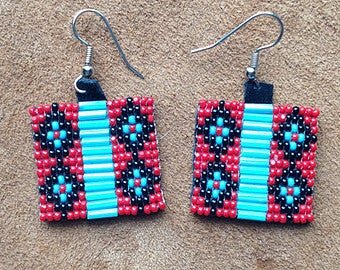
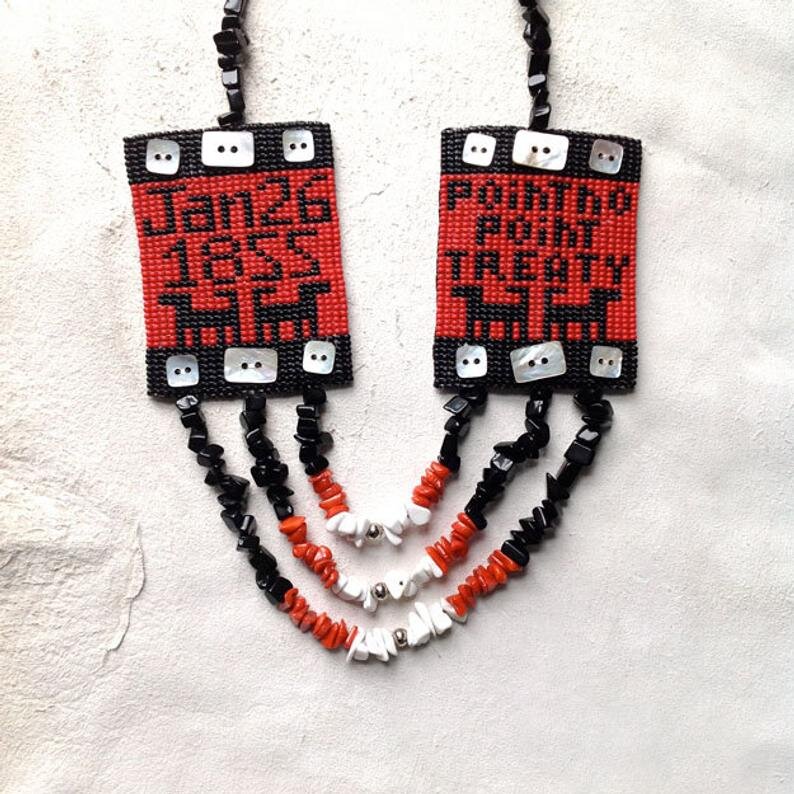
Denise Emerson is enrolled Twana (Skokomish) on her mother's side and Diné (Navajo) on her father's side.
Denise is something of a time traveler. She has found a way to link the past and the future through her native heritage and her modern graphic design skills. This link has allowed her to find a path between traditional Native beadwork and digital art. "I strive to create contemporary art from the original images to give them a different but clearly modern Native women's perspective and to stay in the old world with beads but be creative digitally," she says. Her work truly speaks volumes. The intricate beadwork is fascinatingly beautiful and her haunting digital works breathe life into a past era.
Denise has long been inspired by the people in her life. She was once told by a Filipino coworker that she had "smart hands" - that is her hands knew what to create. She also has been inspired by her parents. "Tradition, heritage, culture," she says. "Words my parents taught me that give me direction on where to concentrate my artistic vision. It's my Native heritage. They taught me that we as Native people had a special and important historical connection to this land." The Diné are matriarchal and have inspired Denise to create art that is centered around women and babies. "The teachings of both parents gave me a broad range of experience and imagination to create culturally specific art," Denise says.
Prior to the pandemic, Denise was contacted by a Google art representative who was interested in her digital art piece called "Moss Babies." At some point, it will become a mural in a Seattle Google office. In addition, she made a digital art piece for "Unkitawa Circle of Indigenous People Celebration", a public event held annually during the Memorial Day weekend at the Seattle Center. She was selected as an Innovative Artist by the Washington State Museum board for her beaded bags as well. "I beaded them," she says, "by creating compositions from historical photos and adding text to them by identifying the tribe, the name (if provided) of the person in the photo, or the name of the historical photo. Each bag took a year to design and at least a month to bead."
Since Covid, Denise has had to rely on her Etsy website for sales and not selling at in-person Native Art Marts has taken a financial toll on her and her family. As we gradually emerge from beneath the weight of Covid, there should be hopeful changes for all of us.
"It's a goal of mine to not forget our ancestors as I do my work," Denise says. "I see their eyes looking at the photographer and it's as if they are looking at me. This connects me to their world and I create art reclaiming them as my ancestors. I feel the need to bring them into our world today."
DYLAN P. SANIDAD, Haida, Tlingit, Tsimshian Artist
Dylan Sanidad (The Diving Eagle) is a Seattle born and raised Alaska Native artist with Haida, Tlingit, Tsimshian and Filipino roots. His journey as a artist began in 2018. He left his career as an aerospace mechanic to pursue his passion to craft and create traditional art. Through the guidance of Tsimshian master carver, David Boxley, Dylan has encompassed techniques to carve, paint and cultivate pieces of his own. Through his art he envisions revitalizing traditional indigenous culture while also elevating with modern concepts.
Growing up I have always been intrigued and fascinated by the art and culture of my Alaskan Native ancestors. Creating unique designs within the traditional system to portray and showcase the pride of my culture. I have been fortunate to help create and restore totem poles while being an apprentice of David. I have gained a lot of experience throughout the years working with him to now be able to create my own pieces and excel my work to my best abilities. Traditional masks, staffs, rattles, paddles, bowls, trays, and regalia are only some of the favorites I enjoy creating. I am proud that our culture was resurrected for my generation and I only want to help continue grow the artwork to new heights for new generations to come.
ANDREA WILBUR-SIGO, Squaxin Island Artist
“When creating my work I try to remember the importance of representing my family and tribe at all times. I remember all those who have left their footsteps for me to follow and those who have planted the roots that have helped me grow into the person I am and the person I’m becoming. I try to teach my children about the importance of protecting those roots and to never forget the importance of them, because with out the roots we will never be grounded and will one day fall. That is how all Id like to think all my pieces start their journey from my hands.”
Andrea Wilbur-Sigo lives in Shelton, Washington where she was born in 1975 and is a member of the Squaxin Island Tribe. She is the daughter of Andy and Ruth Wilbur-Peterson, granddaughter of Bert and Arline Wilbur great-granddaughter of Andrew and Betty Peterson and great-great granddaughter of Henry and Alice Allen of which Henry was one of the major historical and cultural informant for an ethnographic study of the Twana and Salish people.
Andrea is the first known native woman carver of many generations of carvers. She grew up with many types of art around her. She started out with beadwork and has since mastered Coast Salish art forms including bentwood boxes, welcome figures, house posts, masks, panels, button blankets, twine, twill and baskets weaving.
Andrea did her first show in December, 1997, then in May, 1998 she participated in the First Annual Indian Art Northwest show in Portland, Oregon where she took 1st place and Honorable Mention. In 2006 Andrea attended the Heard Museum Show for the first time and took first place in her division. She also took best of show and People’s Choice at the first Annual Native art show, which took place at the Tacoma History Museum. In 2007 Andrea once again took People's Choice at the second Annual Native art show in Tacoma Washington.
Andrea's attention to detail and unique approach to each piece has made her work sought after by collectors through United States, Canada and Europe. She is an active member of her tribe, volunteering her time and artwork for a number of community events. She also teaches Coast Salish art classes on a regular basis to children and adults of all ages.
PETER BOOME, Coast Salish Artist
“Art is everywhere in life, there are lines, curves, shapes, colors, and shades all around us. Each culture has its own way of expressing their view of our world, a window through which we see. I am a Coast Salish Artist. My art is rooted in a historical design tradition. My art is a direct reflection of my culture; it is also a reflection of my personal, cultural, and spiritual world view.
Art is more than a reflection of culture, art influences and guides cultures. If you accept that art and culture are intrinsically connected, you realize that art, like culture, is malleable, while based on a historic foundation both continue to evolve and expand. Our use and need of art is as strong as our use and need of culture. It is intrinsically connected; it surrounds us, often guides us. As an artist representing a distinct culture there is a moral obligation to carry on artistic tradition with the utmost care and respect. We must carry on this tradition by honoring the past, representing the present, and laying the foundations for the future.”
Coast Salish artist Peter Boome is an enrolled member of the Upper Skagit Tribe of Washington State. Coast Salish work is a regionally specific indigenous art form whose only authentic creators are Indigenous Coast Salish peoples from the Salish Sea areas of British Columbia Canada, and Washington State. Peter works in a wide variety of mediums but is best known for his graphic hand-pulled serigraphs that he prints himself. Peter has won numerous national awards for his painting, carving and print-making. His work is show in museums, galleries, and private collections around the world, and is part of numerous permanent collections.
Peter earned his AA from Northwest Indian College, his BA, and MES from the Evergreen State College and his JD from the University of Washington School of Law. In addition to his artistic pursuits, Peter is a mediator, practicing attorney, and a college professor.
Website- araquindesigns.com
Facebook- peter.boome
Instagram- peterboome
Gallery Onyx Exhibit Added July 2020 (below)
“As part of Northwest Art Alliance’s mission to give exposure to the artists of the northwest, and to be inclusive of our communities, we are highlighting a group of African American visual artists living in the Seattle area. Some of these artists have been painting for many years, like Ashby Reed who hails from New York and worked as a professional graphic designer and creative director in advertising while painting on the side; to Earline Alston who started painting in 2014 as a way to heal from brain surgery. These artists paint with different styles, mediums, and subject matter. What they all have in common however, is a strong desire to express their creativity through their art and the experience of being Black in America.”
— Pamelagrace Beatty, NWAA Board of Directors
Clifford Crawford
Artist Clifford Crawford
My love of photography started with old family photos as means to connect with my history. Overtime it has involved from journalism, portraits, sports and fine art. The bottom line I create whatever interests me, you can classify as anything you like but my work reflects what I see and how I feel made for me (in the same way music is played). The beauty of creating is reaching out to others without ever saying a word.
Bars or Stripes by Clifford Crawford
Musicsynthesis by Clifford Crawford
Tracy Poindexter-Canton
Tracy Poindexter-Canton is a mixed media artist in Spokane, Washington. Through collage, vibrancy and portraiture, Poindexter-Canton examines Black American identity and melding literary imagery with visual art. An eclectic assortment of media and materials are incorporated into her work – often including acrylics, oil pastels, ink, feathers, beads, magazine clippings, bubble wrap, scrapbook paper, nylon cord and found objects.
Poindexter-Canton has exhibited her work in Spokane and through Onyx Fine Arts Collective exhibits in Richland and Seattle.
www.tracypoindexter-canton.com
Facebook (@artbytpc)
Instagram (@artbytpc)
My Rose of the World by Tracy Poindexter-Canton
Cabbage Roses by Tracy Poindexter-Canton
Bonnie Hopper
My work tends to be tactile. I’ve always been drawn to the idea of creating art that people can experience through touch as well as sight. My subjects are a series of observations pulled from the onrush of everyday life. For example, a visual snapshot of something completely mundane will strike a chord and lead me on a journey. If I’m blessed, at the end of that journey is an extraordinary work of art.
For Colored Girls by Bonnie Hopper. (Acrylic on yupo paper 30x40)
The Gathering by Bonnie Hopper (Acrylic on canvas 30x40)
Shayla Harris
I believe The Arts allow us to explore self, express what words can't, and embolden those who're often voiceless. I'm just beginning to explore the professional art world, so I'm excited to evolve with Chez la Harris. Chez la Harris is the name I chose for my Fine Art Projects, sounds like my name when said aloud, and is a place where I can lean into my fears and explore the subjects my heart's drawn to. If my work ends up touching the lives of others along the way, what a blessing!
https://www.etsy.com/shop/ChezLaHarris
Instagram (@chezlaharris)
As You Are by Shayla Harris
Origin by Shayla Harris
Ashby Dawson Reed, Jr.
Having been in Commercial Art all my life as a Creative and now retired, I am having a wonderful time transitioning back to my first love, the Fine Arts. My work can best be described as Impressionistic but since I never really did what I always wanted to do artistically; I find myself enjoying the journey of experimentation. Acrylics, Oils, Pastels are my favorite mediums right now as I enjoy them the most. I do real life subject matter depicting African American life and Urban Cityscapes because they create a sense of emotion that I can relate to.
Anywhere Cityscape IX by Ashby Dawson Reed, Jr. Acryllc pallet knife on particle board over compound paste for texture, framed with cherry wood.
Urban Despair by Ashby Dawson Reed, Jr. - As displayed on the Washington State Minority and Justice Commission Poster
Earline Alston
A resident of Seattle, Washington since 1966, I practice a meditative art process to render impressionistic landscapes informed by the Pacific Northwest. I use chalk pastel, oil pastel and acrylic to create colors, shapes, detailed patterns and textures which continuously morph, creating movement and multiple perspectives. These media combinations create an ethereal quality, and evoke feelings that Spirit illuminate’s nature.
Autumn Showers by Earline Alston
Feminine Nature by Earline Alston
Vincent Keele
My paintings are portals that create a metaphysical realm where every thought and action is balanced by its counterpart. Within this infinite expanse I've created a harmonious space where cognitive thought, directed energy and the immeasurable meet analytical thinking.
Each artwork is brought to life through bold delightful flowing lines with luminous color. Becoming one with the fractal allows me to transcend the 2D space where I can expand, retract and exist. Once connected with thought and energy I begin to harness the feeling. My actions of applying acrylic paint create energy around me as I shift and circle the canvas rhythmically, bringing to visual life the internal fight and harmony of Yin and Yang.
I am interested in awakening cognitive thought, harnessing creative energy and to research the limits of universal thinking.
Earnest D. Thomas
I am curious about relationships utilizing non-traditional items and objects. I want to explore, create and find a connection between the second and third dimension and hopefully render a result which is visually pleasing and thought provoking.
Planar Views 1-2 by Earnest D. Thomas
The Blues by Earnest D, Thomas
Lo Mar
With a background in neuroscience, cognitive science, and psychology, as well as a commitment to self-love and a passion for art, I am eager to share what I’ve come to know, my stories, and my creations, with others. It is my intention to feel love, radiate love, and embody love during every phase of the creation and sharing process because doing so is nourishing to my own self-love and fills my being with such joy and appreciation. In regards to painting specifically, I allow each piece to surprise and delight me as I flow with the rhythm of each brush stroke and allow fun to be my dominant intent.
To learn more about Lo Mar’s Art, my stories, thoughts, and creations, feel free to explore the contents of www.LoMarsArt.com.
Trust by Lo Mar
Damon Brown
I am a SeattIe, WA based artist who, from an early age, knew I loved art and to create new designs. I drew inspiration from comic books as I spent countless hours exploring different images and heroic storylines which opened my eyes to artistic creation. As my imagination grew, I began to study various art movements, illustration styles, and urban art. This, in turn, taught to me how things like color, shape, story, and texture can manifest into something so vivid for people to feel and see.
Rose Up by Damon Brown
Each Other by Damon Brown
Anita Coby
Artist Anita Coby
My work directs the viewer to discover a feeling of positive emotions through the movement and positioning of color. With portraits I start with eyes as my focal point to direct the intention of the painting. Through the eyes, the viewer is led to connect with the feeling the painting is portraying.
https://www.cobycodesigns.com
Orion’s Light by Anita Coby
Maya Angelou by Anita Coby






